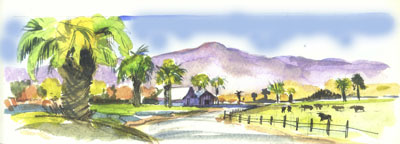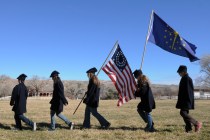Upper Moapa Valley offers unusual scenery, glimpses into past and future
An almost forgotten corner of Nevada, the upper Moapa Valley supports a growing population and an agricultural-based way of life first established by Mormon pioneers during frontier times. Located just an hour's drive north of Las Vegas, the region lies along Highway 168 between Interstate 15 and U.S. 93. Side roads provide glimpses of the past and the future, as well as unusual scenery.
To reach the area, head north on I-15 toward Glendale, some 47 miles distant. Turn off just before you reach Glendale at exit 88 onto Hidden Valley Road. This paved side road drops down into a verdant area just out of sight of the passing freeway traffic. It passes close to an abandoned dairy with empty feeding enclosures and derelict buildings. Nearby fields no longer grazed by livestock await new purpose, perhaps as future subdivisions, although the floodplain location troubles locals.
Hidden Valley Road dips into an overflow section where the Muddy River drainage carries occasional floodwater. Short and curvy, the road approaches the Reid Gardner Power Generating Plant, an economic mainstay and an accepted eyesore. Tall smokestacks raking the sky, the plant sits near the railroad for easy access to rail cars carrying the coal that fires the facility. Interestingly, signs posted along a roadway through the neighboring Moapa River Paiute Reservation list phone numbers to call to report emissions violations at the plant.
Just beyond the plant, the road passes a cluster of ramshackle remnants of the former Moapa railroad siding left over from the era of steam trains that needed frequent watering stops. Hidden Valley Road continues just beyond the tumbledown wooden residences and offices to junction with Highway 168.
The grid of streets, commercial concerns, school and churches marking the community of Moapa lie on the far side of the highway. A popular restaurant sits a mile or so east, although the older eatery at the Glendale exit also draws many patrons. Glendale still serves passing freeway traffic, but it once also served traffic headed for Ely on U.S. 93. Construction of an extension of U.S. 93 from Apex created the route now traveled as the Great Basin Highway.
Because of numerous springs, creeks, the Muddy River and the confluence of water in the Meadow Valley Wash, the region early drew human inhabitants. Nomadic hunters and gatherers arrived first. Later people farmed, mined salt and built pueblo-style villages, primarily on the lower Muddy River.
The first non-native settlers arrived in the area in 1867, establishing a small settlement called West Point about three miles north of Glendale. About 20 Mormon families endured Indian attacks, floods, insects, heat, hunger and poor harvests in the first few years. They upped stakes in 1870 to relocate to better prospects elsewhere in the vicinity. Finally, church leader Brigham Young ordered the Mormon settlers out of the area in 1871. Some years later, they returned with new vigor, establishing communities, farming, ranching and creating a lifestyle based on agriculture that endures despite many changes.
Turn left at the Highway 168 junction, passing a couple of access roads to residential portions of the reservation before approaching the turnoff for Warm Springs Road. This winding country side road returns to Highway 168 a few miles to the west. Vast stands of palm trees characterize this backcountry drive.
For decades, people crowded this byway as they flocked to two swimming resorts boasting several pools fed natural warm springs in the upper Moapa Valley. No one then knew that the water created habitat for the Moapa dace, a unique species of small, silvery fish found nowhere else. Listing the Moapa dace as an endangered species spelled dramatic changes.
The U.S. Fish and Wildlife Service proposed acquiring the resort properties for a wildlife refuge aimed at saving the little fish. In 1979, the Moapa Valley National Wildlife refuge came into being. Although property acquisition continued, slow development resulted from miniscule budgets and almost no staff. Long-promised public access remains years away, but travelers on Warm Springs Road see the first stages of visitor facilities under construction on a seasonal basis.
Margo Bartlett Pesek's column appears on Sundays.
MARGO BARTLETT PESEKMORE COLUMNS






















